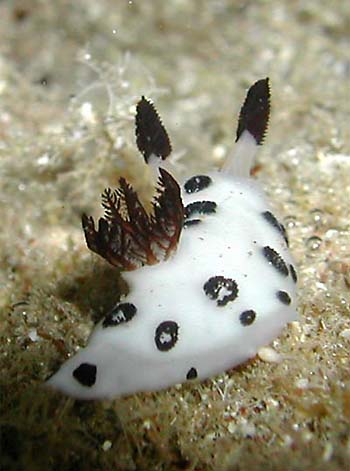This species has been observed on Reunion, Mayotte, Madagascar, Mauritius and Seychelles Islands
Species characteristics : The oval elongated body is white with round or oval patches containing black papillae ; these are spiculose, giving a spiky appearance to the animal The rhinophores have a translucent stalk and black or brown clavus The six, black or brown, quite sparsely branched gills form a complete circle around the anus |

|
|
| Showing species characteristics... | Photo Hugues Flodrops |
|
See more about : Jorunna funebris variability in Southwest Indian ocean
See more about : Jorunna funebris eats sponges of different colour...
See more about : Sightening and mating periods
Remarks :
Identification confirmed by Bill Rudman
Synonymous (according worms) :
- Discodoris wetleyi, Allan, 1932 - Kentrodoris funebris, (Kelaart, 1859)
- Doris funebris, Kelaart, 1859 - Kentrodoris gigas, Bergh, 1876
- Jorunna zania, Ev. Marcus, 1976 - Kentrodoris maculosa, Eliot, 1906
- Kentrodoris annuligera, Bergh, 1876
Bibliographic data :
Its mantle is covered in small spiculate papillae (caryophyllidia) which are characteristic of that genus.
The pattern and density of black spicules is variable.
- The most colour form has the rings occupying about one-quarter of the area of the mantle.
- Specimens occasionally also occur in which the rings are reduced in size so the mantle is almost pure white,
- whilst some specimens had the rings on the mantle so large that they virtually coalesced.
There are similar black or brown rings on the upper surface of the tail
In juvenile form the black spots are in fact open rings and as they grow the other apparent spots will also expand in size and become black rings
J.funebris is a sponge feeder. It seems that it eats different sponge species.
- Sylvain Le Bris observed Jorunna funebris on a blue sponge : Xestospongia sp. in all the eastern Gulf of Thailand
- Gustav Paulay observed Jorunna funebris on a blue sponge : the species called “blue aquarium Haliclona”, an undescribed species of Haliclona, on Marianas island
- Bill Rudman observed Jorunna funebris on a blue sponge identified as Euplacella cf. australis
- According Richard Willan, on Heron Island, it is regularly observed on the blue siliceous sponge Ianthella flabelliformis
- According Gosliner it feed on the bright blue sponge, Haliclona sp 2 (sp 28 in Coral reef Animals of the Indo-Pacific, Terrence M.Gosliner)
In our area, we have only two observations of feedind behavior, in two different sponge.
According to Johnson & Boucher (1983), this species lays a white spawn mass consisting of a coil of three, loose whorls, being attached by one edge to the sustrate.The ova (170 µm diameter) occur individually within capsules (240 µm)
References :
Bill Rudman Seaslug site : Sea Slug Forum : Jorunna funebris
Nudipixel Jorunna funebris
Publications :
Camacho-García Y.E. & Gosliner T.M. (2008). Systematic revision of Jorunna Bergh, 1876 (Nudibranchia: Discodorididae) with a morphological phylogenetic analysis. Journal of Molluscan Studies 74 : 143-181
Johnson, S. & Boucher, L.M. 1983. Notes on some Opistobranchia (Mollusca: Gastropoda) from the Marchall Islands, including 57 new records. Pacific Science 37(3): 251-29
Kelaart, E.F. (1858). Description of new and little known species of Ceylon nudibranchiate molluscs and zoophytes. Journal of the Ceylon Branch of the Royal Asiatic Society, Columbo, 3(1) : 84-139.
Other photos of Jorunna funebris :
 |
Philibert Bidgrain mtsanga jimaweni, Mayotte, less 1m, on the reef flat zone, 23 October 2008, size : 20 mm. Presence of a white axis an the anterior side of the rhinophore  |
Olivier Aubrespin In this photo you can see the lamellate structure of the rhinophore, and its mantle, covered in small spiculate papillae (caryophyllidia) which are characteristic of that genus.
|
 |
 |
Hugues Flodrops Réunion, Etang salé les bains on a rocky coast, 16 January 2007 at 19H20, size 30-35 mm Presence of a white axis an the anterior side of the rhinophore |
Philibert Bidgrain Réunion, Etang salé les bains on a rocky coast, 1 Jully 2007, size 15-20 mm Gills with a pale brown coloration |
 |
 |
Alain-Benoît Rassat Madagascar, Nosy bé, Anémone, 14 m, 12 August 2013, size : 50 mm A specimen with a pale brown coloration. |
Sébastien Vasquez Réunion, Etang salé les bains on a rocky coast, 28 November 2015
Mating behavior, during the night
|
.jpg) |
More photos from Indian Ocean
See more about : Jorunna funebris variability in Southwest Indian ocean
See more about : Jorunna funebris eats sponges of different colour...
Mayotte, a large Jorunna funebris, at Passe en S, by Matthias Deuss
Reunion, Jorunna funebris, at Etang salé, by Hugues Flodrops
Mayotte, a small Jorunna funebris, at M'Bouini, by Matthias Deuss
Mayotte, a small Jorunna funebris, at Mbouanatsa, by Matthias Deuss
Seychelles, Jorunna funebris, at Mahé, by Christophe Mason-Parker
Mauritius, Jorunna funebris, at Rivière Noire, by Pierre Périès